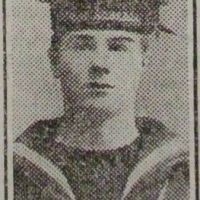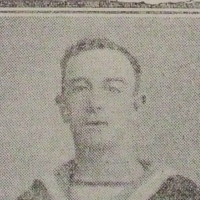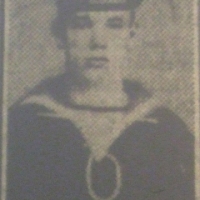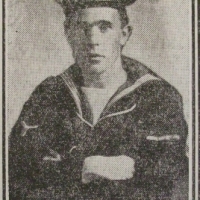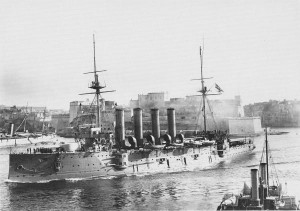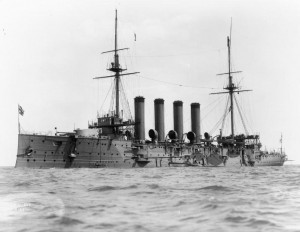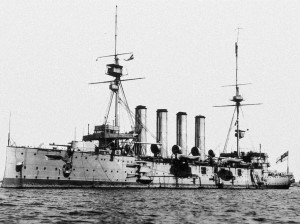The sinking of HMS HAWKE: One of the greatest single losses of Royal Navy sailors from Ulster with 49 Ulstermen lost to just one U-boat
During the week when the Royal Navy traditionally remembers the Immortal Memory of Admiral Nelson and his final victory at the Battle of Trafalgar in 1805, it is worth pausing to reflect on the centenary of a naval incident that had a significant impact on so many Ulster families, the sinking of HMS Hawke. One of the greatest single losses of Royal Navy sailors from Ulster, this incident occurred on the 15th October 1914 when the German Submarine U-9 which was patrolling the North Sea came across two British Cruisers HMS Hawke and her sister ship HMS Theseus.
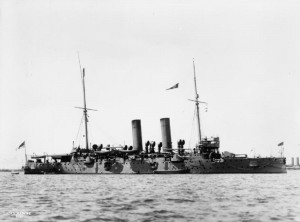 Under the command of German hero Commander Weddigen, U-9 fired on the British ships. This was the same German submarine which had caused the deaths of almost 1500 British seamen only 3 weeks earlier with the torpedoing of the ‘Livebait Squadron’. The submarine’s first torpedo hit HMS Hawke, igniting a magazine and causing a tremendous explosion which ripped much of the ship apart. Hawke sank in a few minutes with the loss of her Commander and 523 men. Only 74 men were saved.
Under the command of German hero Commander Weddigen, U-9 fired on the British ships. This was the same German submarine which had caused the deaths of almost 1500 British seamen only 3 weeks earlier with the torpedoing of the ‘Livebait Squadron’. The submarine’s first torpedo hit HMS Hawke, igniting a magazine and causing a tremendous explosion which ripped much of the ship apart. Hawke sank in a few minutes with the loss of her Commander and 523 men. Only 74 men were saved.
Sailors from Ulster lost on Hawke included the tragic loss of three fathers-to-be, leaving pregnant wives to fend for themselves throughout the difficult war years.
-Leading Stoker Joyce Power left young twins and a pregnant wife in Ballymena. His daughter Margaret Hawke Power named after the ship he was killed on.
-Also drowned was Able Seaman Albert Patterson Wilson whose first daughter Frances was born only 4 weeks later on 14 November.
-Mariette Isabella Donald was born at the end of 1914, her father Martie Donald not returning to Carrickfergus to meet his newborn daughter.
-The Gorman siblings from Clifton Park in Belfast lost one brother, Charles on HMS Pathfinder in September only to hear of the death of another brother, Able Seaman James Toland Gorman, only one month later on HMS Hawke.
-Sullatober Flute band from Carrickfergus who lost one of their players Henry McMurran on HMS Cressy just 3 weeks before, suffered yet another tragedy with the loss of another member, Stoker (1st class) Andrew McAllister.
-Another loss for Ulster was Lieutenant Commander Ruric Henry Waring, the first of the sons of Colonel Thomas Waring JP of Waringstown to be killed. Ruric’s younger brother Major Holt Waring would be killed in 1918 at the Front.
In August 1914, at the outbreak of the First World War, Hawke was part of the 10th Cruiser Squadron, operating on blockade duties between the Shetland Islands and Norway. In October 1914, the 10th Cruiser Squadron was deployed further south in the North Sea as part of efforts to stop German warships from attacking a troop convoy from Canada. On 15 October, the squadron was on patrol off Aberdeen and HMS Hawke stopped at 0930 to pick up mail from her sister ship HMS Endymion. Hawke proceeded to return to her station without zig-zagging to avoid danger, and was out of sight of the rest of the Squadron when a single torpedo from U-9 struck Hawke and she quickly capsized. The remainder of the Squadron only realised something was wrong when, after a further, unsuccessful attack on Theseus, they were ordered to retreat and no response was received from Hawke. The destroyer Swift was dispatched from Scapa Flow to search for Hawke and found a raft carrying 22 men, while a boat with a further 49 survivors was rescued by a Norwegian steamer.
524 men drowned, including the ship’s Captain, Hugh P. E. T. Williams, and 49 Ulstermen. Only 74 men were saved, of which 6 were from Ulster.
A surviving Stoker explained:
‘Those on deck for an instant immediately after the explosion saw the periscope of a submarine which showed above the water like a broomstick. The Hawke was holed above the engine room and commenced to cant over to starboard with alarming rapidity. Her plates were twisted and torn and a huge gap was rent in her side. An attempt to man the guns was made but owing to the extra acute list of the vessel it was found impossible to train them on the submerged craft. The horror of the situation was added to when a tank of oil fuel caught fire and the flames advanced with fatal rapidity. Seeing there was not the ghost of a chance of doing any good by remaining in what was obviously a death trap I determined to make a dash for it. I scrambled precipitately up the iron ladder to the main deck. All this had happened in less time than it takes to tell.’
He continued:
‘But such is British pluck and coolness of nerve even in the face of such a situation that already after the initial shock the Captain, Commander and a midshipman were on the bridge and calmly on the fleet manoeuvre in the Solent, orders were given out and calmly obeyed. The bugler sounded the ‘Still’ call which called upon every man to remain at the post in which the call reached him. Apparently during the first minute or two, the belief was entertained that all that was wrong was the boiler explosion, but the rapidity with which the cruiser was making water on her starboard side rudely and quickly disputed all minds of this belief.’
Another survivor explained that:
‘The Captain, Commander and the midshipman had stuck bravely to their posts on the bridge to the last, and were seen to disappear and the ship finally plunged bow first amidst a maelstrom of cruel, swirling waters’
One survivor when interviewed pointed out that:
‘the crew for the most part were Irishmen, the reason being that at the outbreak of war the Hawke which was one of the oldest ships of the British Navy, was stationed at Queenstown… there were only around 24 active servicemen on board, the remainder being fleet reservists’
None of these men’s bodies was recovered for burial, most remaining where they drowned. The centenary of the sinking of HMS Hawke and the tragic loss of so many men of Ulster will be remembered at the Royal Navy’s annual Trafalgar Day Service in Belfast on 19th October 2014.
Ulstermen known to have died on HMS Hawke are:
Stoker (1st class) Nathaniel Agnew, born Belfast
Able Seaman Robert Algie, born Belfast
Stoker (1st class) David Bell, born Ballymena
Stoker (1st class) George Jackson Campbell, born Belfast
Stoker (1st class) John Chisim, born Belfast
Stoker (1st class) Hugh Patrick Cormican, born Belfast
Able Seaman Hugh Crawford, born Belfast
Stoker (1st class) Robert Creighton, born Larne
Stoker (1st class) James Dickey, born Belfast
Stoker (1st class) Mariott (Martie) Robert D Donald, born Carrickfergus
Petty Officer (1st class) William James Elkin, born Coleraine
Stoker (1st class) Samuel Fee, born Belfast
Stoker (1st class) William John Gillespie, born Lisburn
Able Seaman James Toland Gorman, born Belfast
Stoker (1st class) William Greer, born Ballybay, Monaghan
Stoker (1st class) Robert John Hamilton, born Belfast
Stoker (1st class) William James Harper, born Belfast
Stoker (1st class) Robert Hunter, born Belfast
Able Seaman William Johnston, born Carrickfergus
Stoker (1st class) Isaac Lewis, lived Belfast
Stoker (1st class) Andrew McAllister, born Carrickfergus
Able Seaman David McCaugherty, born Belfast
Stoker (1st class) Hugh McComb, born Belfast
Stoker (1st class) William McFarlane
Stoker (1st class) James McNally, born Belfast
Stoker (1st class) John Mills, born Belfast
Chief Petty Officer Charles Molloy, born Drumragh, Tyrone
Stoker (1st class) Edward Mullen, born Belfast
Able Seaman William James Ross, born Belfast
Leading Stoker Joyce Power, born Ballymena
Stoker (1st class) Thomas Henry Sefton, lived Belfast
Stoker (1st class) John Smyth, born Belfast
Stoker (1st class) Archer Thompson, born Belfast
Stoker (1st class) David Tully
Stoker (1st class) Charles Edward Uprichard, born Lurgan
Stoker (1st class) Henry Wasson, born Belfast
Stoker (1st class) James Wilson, born Newry
Able Seaman Albert Patterson Wilson, lived Belfast
Stoker (1st class) John Yates, born Belfast
Boy (1st class) Clare Robert Adams, born Enniskillen
Stoker (1st class) William Clarke, born Belfast
Stoker (1st class) Edward Crossin, born Belfast
Able Seaman John Thomas Gibson Dawson, born Belfast
Able Seaman James Charles Gamble, born Belfast
Stoker (1st class) Daniel Laverty, born Belfast
Stoker (1st class) Alexander Mairs, born Ballymena
Leading Stoker Patrick McEvoy, born Dechomet, Banbridge
Stoker (1st class) Hugh McGinley, born Inch Island, Donegal
Lieutenant Commander Ruric Henry Waring, born Waringstown
*Research by Karen O’Rawe, Chair History Hub Ulster and William Hull, Research Assistant, Now Project.
*Three years before, on 20 September 1911, Hawke, under command of Commander W. F. Blunt, collided in the Solent with the White Star liner RMS Olympic. In the course of the collision, Hawke lost her bow. The subsequent trial pronounced Hawke to be free from any blame. During the trial, a theory was advanced that the large amount of water displaced by the Olympic had generated a suction that had drawn Hawke off course. The decision of the first court to try the case provoked a series of legal appeals.
*There were 6 known Ulster men who survived the tragedy. These were: Charles Trainer from Derry, JA Allen from Belfast, Thomas H Doyle from Belfast, Thomas Hoy from Larne, John Aitken, from Belfast and James O’Neill, from Belfast.
*Newspaper photographs courtesy of History Hub Ulster member, Nigel Henderson at http://www.greatwarbelfastclippings.com
History Hub Ulster is a research group based in Belfast, but working on projects across Ulster.
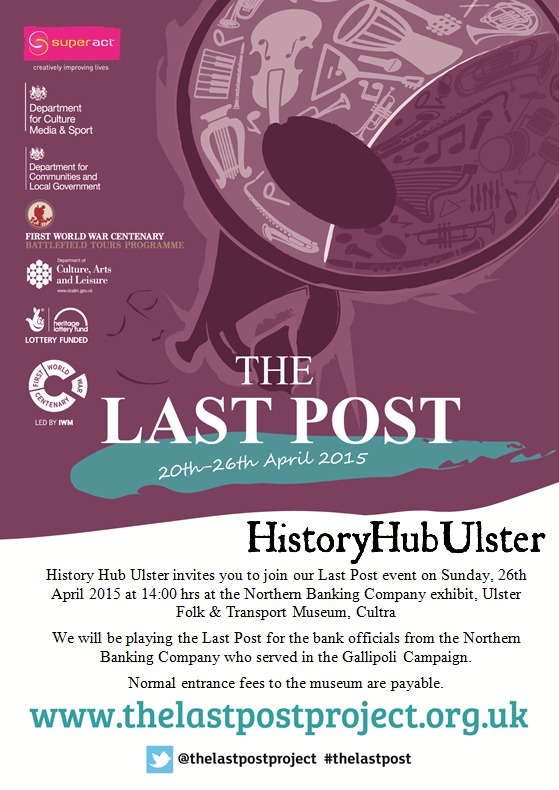



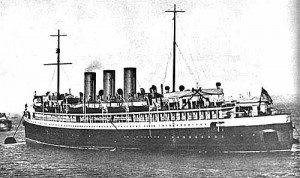
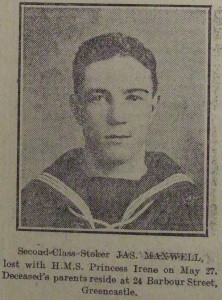
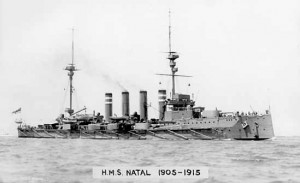
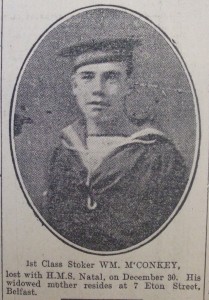
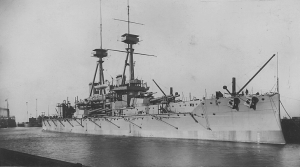
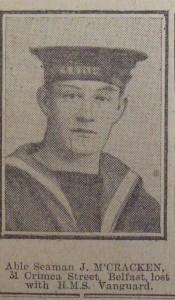
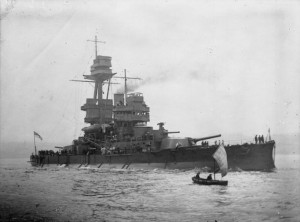
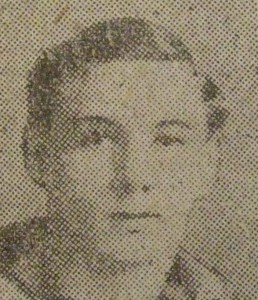
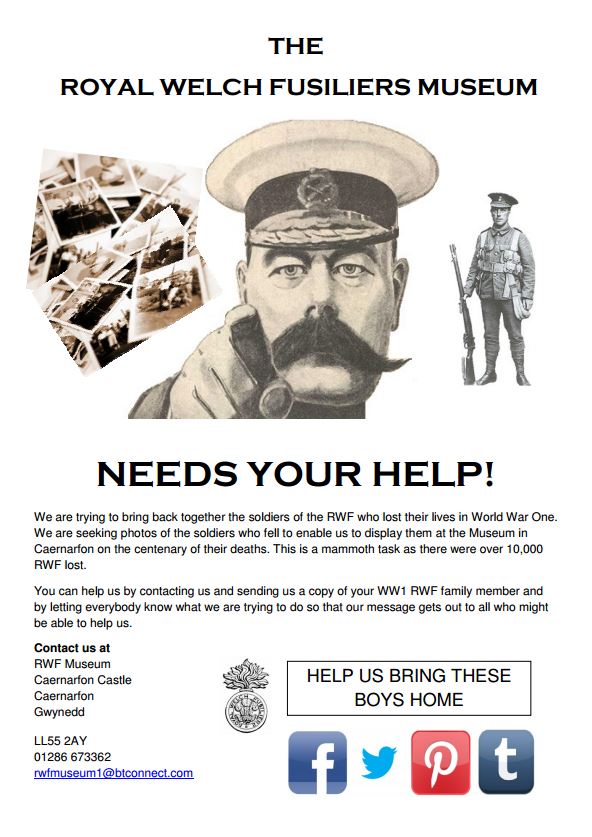

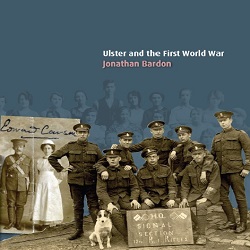 PRONI is pleased to invite you to a lunchtime lecture by renowned author and historian
PRONI is pleased to invite you to a lunchtime lecture by renowned author and historian 
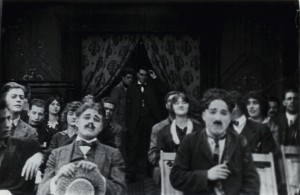 Other highlights include:
Other highlights include: 
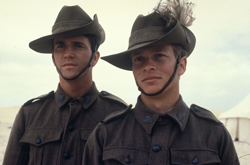 Other films in the programme include: the dazzling technicolor satire
Other films in the programme include: the dazzling technicolor satire  Under the command of German hero Commander Weddigen, U-9 fired on the British ships. This was the same German submarine which had caused the deaths of almost 1500 British seamen only 3 weeks earlier with the torpedoing of the
Under the command of German hero Commander Weddigen, U-9 fired on the British ships. This was the same German submarine which had caused the deaths of almost 1500 British seamen only 3 weeks earlier with the torpedoing of the 